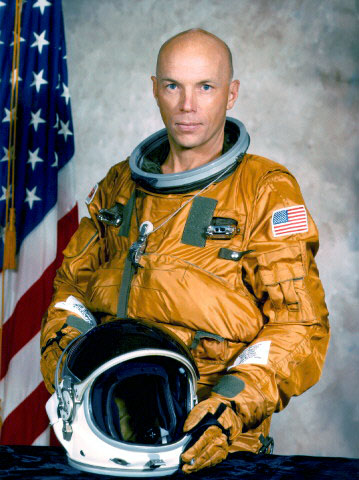Story Musgrave
American - (NASA)
Retired
Date of Birth: Aug. 19, 1935
Age: 90
Franklin Story Musgrave, M.D. is an American physician and a retired NASA astronaut. He is a public speaker[2] and consultant to both Disney's Imagineering group and Applied Minds in California. In 1996 he became only the second astronaut to fly on six spaceflights, and he is the most formally educated astronaut with six academic degrees.
Space Shuttle Challenger / OV-099 | STS-6
National Aeronautics and Space Administration | United States of AmericaKennedy Space Center, FL, USA
April 4, 1983, 6:30 p.m.
Status: Success
Mission:
STS-6 was the maiden flight of the Space Shuttle Challenger. It deployed the first Tracking and Data Relay Satellite into orbit for NASA, forming an integral part of NASAs in-space 10. It was also the first Space Shuttle mission involving a spacewalk. It was the first mission in which the Extravehicular Mobility Unit (EMU) was used.
Low Earth OrbitSpace Shuttle Challenger / OV-099 | STS-51-F
National Aeronautics and Space Administration | United States of AmericaKennedy Space Center, FL, USA
July 29, 1985, 9 p.m.
Space Shuttle Discovery / OV-103 | STS-33
National Aeronautics and Space Administration | United States of AmericaKennedy Space Center, FL, USA
Nov. 23, 1989, 12:23 a.m.
Space Shuttle Atlantis / OV-104 | STS-44
National Aeronautics and Space Administration | United States of AmericaKennedy Space Center, FL, USA
Nov. 24, 1991, 11:44 p.m.
Space Shuttle Endeavour / OV-105 | STS-61
National Aeronautics and Space Administration | United States of AmericaKennedy Space Center, FL, USA
Dec. 2, 1993, 9:27 a.m.
Status: Success
Mission:
STS-61 was the first Hubble Space Telescope servicing mission, and the fifth flight of the Space Shuttle Endeavour. The mission launched on 2 December 1993 from Kennedy Space Center in Florida. The mission restored the spaceborne observatory's vision, marred by spherical aberration, with the installation of a new main camera and a corrective optics package. This correction occurred more than three and a half years after the Hubble was launched aboard STS-31 in April 1990. The flight also brought instrument upgrades and new solar arrays to the telescope.
Low Earth OrbitSpace Shuttle Columbia / OV-102 | STS-80
National Aeronautics and Space Administration | United States of AmericaKennedy Space Center, FL, USA
Nov. 19, 1996, 7:55 p.m.
Status: Success
Mission:
STS-80 was a Space Shuttle mission flown by Space Shuttle Columbia. The launch was originally scheduled for 31 October 1996, but was delayed to 19 November for several reasons. Likewise, the landing, which was originally scheduled for 5 December, was pushed back to 7 December after bad weather prevented landing for two days. The mission was the longest Shuttle mission ever flown at 17 days, 15 hours, and 53 minutes. Although two spacewalks were planned for the mission, they were both canceled after problems with the airlock hatch prevented astronauts Tom Jones and Tammy Jernigan from exiting the orbiter.
Low Earth OrbitThe National Aeronautics and Space Administration is an independent agency of the executive branch of the United States federal government responsible for the civilian space program, as well as aeronautics and aerospace research. NASA have many launch facilities but most are inactive. The most commonly used pad will be LC-39B at Kennedy Space Center in Florida.
Ariane 62
Galileo L14 (FOC FM33 & FM34)
Ariane Launch Area 4 - Guiana Space Centre, French GuianaPayload consists of two satellites for Europe's Galileo navigation system.
Atlas V 551
Amazon Leo (LA-04)
Space Launch Complex 41 - Cape Canaveral SFS, FL, USAAmazon Leo, formerly known as Project Kuiper, is a mega constellation of satellites in Low Earth Orbit that will offer broadband internet access, thi…
Long March 4B
Ziyuan-3-04
Launch Complex 9 - Taiyuan Satellite Launch Center, People's Republic of ChinaThe ZY-3 (Ziyuan-3, 'Resource-3') series represents China's first high-resolution, stereoscopic mapping satellites for civilian use. The second sa…
Falcon 9
Starlink Group 6-82
Space Launch Complex 40 - Cape Canaveral SFS, FL, USAA batch of 29 satellites for the Starlink mega-constellation - SpaceX's project for space-based Internet communication system.
Falcon 9
Starlink Group 15-12
Space Launch Complex 4E - Vandenberg SFB, CA, USAA batch of 27 satellites for the Starlink mega-constellation - SpaceX's project for space-based Internet communication system.



